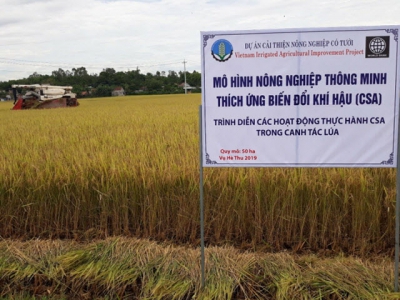Farmers benefited from the irrigated agriculture improvement project

The Vietnam Irrigated Agriculture Improvement Project (VIAIP/WB7) is supported by the World Bank with a total fund of US$210 million including a concessional loan of US$ 180 million and US$30 million as the counterpart fund of the Government of Vietnam. The project has been implemented since 2014. By June 2021, all approved contents and activities of the project were completed.
The Vietnam Irrigated Agriculture Project not only helped farmers reduce production costs, increase profits, but also approach and change their perception of production towards sustainability. Photo: Le Khanh.
The project has four components with Component 1: Support to improve irrigation management ($9.5 million); Component 2: Upgrading irrigation system ($170.5 million); Component 3: Supporting smart agricultural practices to adapt to climate change ($23 million) and Component 4: Project management, monitoring and evaluation ($7 million).
The objective of Component 3 is based on improved irrigation infrastructure in Component 2 of the Project, smart agricultural practices adapted to climate change to improve productivity and quality of agricultural production, increase the efficiency of water use, increase farmers' income and reduce vulnerability to adverse climate changes, reduce greenhouse gas emissions, thereby drawing lessons from experience to expand throughout the project area and the whole country.
In Component 3, smart agricultural practice models were built to adapt to climate change. The models were then expanded in the project area. Measures to minimize water consumption and environmental impacts of rice farming systems were implemented. The modernization through the use of sprinkler and drip irrigation systems was promoted.
Component 3 also offered training for farmers and supports to the Ministry of Agriculture and Rural Development to upgrade the information dissemination system on smart agriculture adapting to climate change.
When implementing the project, provinces such as Ha Giang and Hoa Binh still have many limitations as the model is located outside the area of Component 2 because most of the irrigation systems of Component 2 are small in scale, with a small irrigation area, mainly serving rice cultivation, while the climate change adaptive smart agriculture model focuses on fruit trees.
Technically, through monitoring and summarizing, it can be seen that the factors contributing to the effectiveness of the models include saving water for irrigation by reducing the number of watering times, reducing the amount of irrigation water, reducing the amount of seed used, reducing the amount of water used for irrigation, reducing fertilisers and pesticides.
Among rice production models, those for rice production in large areas and models that converted rice land to growing vegetables generated the highest technical efficiency in terms of reducing watering and the seeds, using slow-release fertilisers, reducing the number of times of spraying pesticides, using microbial organic fertilisers and reducing greenhouse gas emissions from 4.3 - 4.42 tons of CO2/ha/year.
In particular, the model of rotating rice with other crops has the highest pesticide efficiency, and the number of times of pesticide application on crops is reduced from 3 to 6 times/crop compared to conventional farming.
According to Deputy Minister of Agriculture and Rural Development Le Quoc Doanh, the Vietnam Irrigated Agriculture Improvement Project was the first project between the ministry and the World Bank (WB) to integrate irrigation infrastructure with smart agricultural models for multi-values and higher investment efficiency.
The project not only maximized the efficiency of investment in irrigation works but also contributed to the realisation of policies and guidelines of the agricultural restructuring towards sustainability, adaptation to climate change with the Irrigation Development Strategy to 2030 and a vision to 2050.
In Quang Nam Province, the implementation of models of the Irrigated Agriculture Improvement Project shows that applying the sowing method with quality seeds in the rice model reduced by about 30 kg of seed per ha compared with the fields outside the model. Rice plants grow healthy with a reduction in costs, care and fewer pests and diseases.
In the more, pesticide spraying reduced 2.5 times per crop, water was saved 2.7 times compared to the control field. The use of organic fertilizers helped reduce 29.5 kg of urea/ha compared to the field outside the model. The model helped increase by VND7 million/ha/crop compared to the old farming.
In vegetable growing models, mainly peanuts, as farmers applied the IPM model with the use of new varieties and organic fertilisers, pesticide spraying was reduced two times. The average yield of the model is 3.3 quintals/ha higher, the profit is VND10.3 million/ha higher than the field outside the model.
Có thể bạn quan tâm
 BBB breed brings higher income with less effort
BBB breed brings higher income with less effort The Belgian Blue Beef (BBB) Breed that is famous for its impressive height, muscling and beautiful shape could bring much higher income in comparison
 Rice production by sowing tray, planting machine helps reducing half rice seeds
Rice production by sowing tray, planting machine helps reducing half rice seeds Rice production by sowing tray and planting machine contributes to reducing the production costs.
 Lao Cai has 'headache' with over 40,000 tons of pineapple per year
Lao Cai has 'headache' with over 40,000 tons of pineapple per year As an international trade border gate with China, Lao Cai Province has great potential for developing a variety of agricultural, forestry, and fishery products.